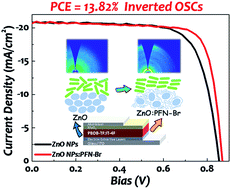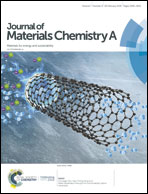Exquisite modulation of ZnO nanoparticle electron transporting layer for high-performance fullerene-free organic solar cell with inverted structure†
Abstract
Since inverted organic solar cells have shown great advantages in achieving good stability, developing effective methods to increase power conversion efficiency is very important for practical applications. The demand for improving the photovoltaic performance has promoted excellent modulations of all components in inverted devices including electron transporting layers. Here, we developed an effective method of achieving systematic tuning of surface free energy of ZnO electron transporting layers with continuous gradation from 51.23 mN m−1 to 76.62 mN m−1 by mixing ZnO nanoparticles with PFN-Br. Based on the highly efficient bulk heterojunction system PBDB-TF : IT-4F, we achieved enhanced open circuit voltage (0.87 V), fill factor (78.79%) and power conversion efficiency (13.82%) in inverted device which is benefitted from the optimized bulk heterojunction morphology on electron transporting layer with 63.89 mN m−1 surface free energy. Moreover, the optimized electron transporting layer showed much better stability than the control ZnO electron transporting layer due to the well-modified dispersity of nanoparticles. Our comprehensive analyses provide deep insights into the recombination/morphology control adjusted by the surface free energy of interfacial layers, which shall be the key factors affecting the device characteristics of inverted organic solar cells.



 Please wait while we load your content...
Please wait while we load your content...